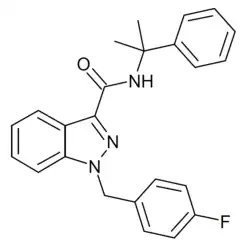CUMYL-FUBINACA |
|
| Legal status |
- DE: NpSG (Industrial and scientific use only)
- UK: Class B
|
|---|
|
1-[(4-fluorophenyl)methyl]-N-(2-phenylpropan-2-yl)indazole-3-carboxamide
|
| CAS Number | |
|---|
| PubChem CID | |
|---|
| UNII | |
|---|
| CompTox Dashboard (EPA) | |
|---|
|
| Formula | C24H22FN3O |
|---|
| Molar mass | 387.458 g·mol−1 |
|---|
| 3D model (JSmol) | |
|---|
CC(C)(C1=CC=CC=C1)NC(=O)C2=NN(C3=CC=CC=C32)CC4=CC=C(C=C4)F
|
InChI=1S/C24H22FN3O/c1-24(2,18-8-4-3-5-9-18)26-23(29)22-20-10-6-7-11-21(20)28(27-22)16-17-12-14-19(25)15-13-17/h3-15H,16H2,1-2H3,(H,26,29) Key:ABBDMPBQHOHMJZ-UHFFFAOYSA-N
|
CUMYL-FUBINACA (SGT-149) is an indazole-3-carboxamide based synthetic cannabinoid receptor agonist, with an EC50 of 1.8nM for human CB1 receptors and 23.7nM for human CB2 receptors, giving it around 13x selectivity for CB1.[1][2][3][4] It has been sold online as a designer drug.[5]
See also
References
- ^ WO 2014167530, Bowden MW, Williamson PB, "Cannabinoid compounds", published 11 April 2013
- ^ Longworth M, Banister SD, Boyd R, Kevin RC, Connor M, McGregor IS, Kassiou M (October 2017). "Pharmacology of Cumyl-Carboxamide Synthetic Cannabinoid New Psychoactive Substances (NPS) CUMYL-BICA, CUMYL-PICA, CUMYL-5F-PICA, CUMYL-5F-PINACA, and Their Analogues". ACS Chemical Neuroscience. 8 (10): 2159–2167. doi:10.1021/acschemneuro.7b00267. PMID 28792725.
- ^ Banister SD, Connor M (2018). "The Chemistry and Pharmacology of Synthetic Cannabinoid Receptor Agonist New Psychoactive Substances: Evolution". New Psychoactive Substances. Handbook of Experimental Pharmacology. Vol. 252. pp. 191–226. doi:10.1007/164_2018_144. ISBN 978-3-030-10560-0. PMID 30105473.
- ^ Krishna Kumar K, Shalev-Benami M, Robertson MJ, Hu H, Banister SD, Hollingsworth SA, et al. (January 2019). "Structure of a Signaling Cannabinoid Receptor 1-G Protein Complex". Cell. 176 (3): 448–458.e12. doi:10.1016/j.cell.2018.11.040. PMC 6461403. PMID 30639101.
- ^ Thornton SL, Darracq MA, Gugelmann HM, Armenian P (2019). "Surface internet marketplace presence and availability of NPS sold as research chemicals: a snapshot study". Toxicology Communications. 3 (1): 67–74. doi:10.1080/24734306.2019.1648067. S2CID 202372196.
|
|---|
Phytocannabinoids
(comparison) | | Cannabibutols | |
|---|
| Cannabichromenes | |
|---|
| Cannabicyclols | |
|---|
| Cannabidiols | |
|---|
| Cannabielsoins | |
|---|
| Cannabigerols | |
|---|
| Cannabiphorols | |
|---|
| Cannabinols |
- CBN
- CBNA
- CBN-C1
- CBN-C2
- CBN-C4
- CBNM
- CBND
- CBNP
- CBVD
|
|---|
| Cannabitriols | |
|---|
| Cannabivarins | |
|---|
| Delta-3-tetrahydrocannabinols | |
|---|
| Delta-4-tetrahydrocannabinols | |
|---|
| Delta-7-tetrahydrocannabinols | |
|---|
| Delta-8-tetrahydrocannabinols | |
|---|
| Delta-9-tetrahydrocannabinols | |
|---|
| Delta-10-Tetrahydrocannabinols | |
|---|
| Delta-11-Tetrahydrocannabinols | |
|---|
| Miscellaneous cannabinoids | |
|---|
| Active metabolites | |
|---|
|
|---|
| Endocannabinoids | |
|---|
Synthetic
cannabinoid
receptor
agonists /
neocannabinoids | Classical cannabinoids
(dibenzopyrans) | |
|---|
Non-classical
cannabinoids | |
|---|
| Adamantoylindoles | |
|---|
| Benzimidazoles | |
|---|
| Benzoylindoles | |
|---|
| Cyclohexylphenols | |
|---|
| Eicosanoids | |
|---|
Indazole-3-
carboxamides | |
|---|
| Indole-3-carboxamides | |
|---|
| Indole-3-carboxylates | |
|---|
| Naphthoylindazoles | |
|---|
| Naphthoylindoles | |
|---|
| Naphthoylpyrroles | |
|---|
| Naphthylmethylindenes | |
|---|
| Naphthylmethylindoles | |
|---|
| Phenylacetylindoles | |
|---|
| Pyrazolecarboxamides | |
|---|
Tetramethylcyclo-
propanoylindazoles | |
|---|
Tetramethylcyclo-
propanoylindoles | |
|---|
| Others | |
|---|
|
|---|
| Allosteric CBRTooltip Cannabinoid receptor ligands | |
|---|
Endocannabinoid
enhancers
(inactivation inhibitors) | |
|---|
Anticannabinoids
(antagonists/inverse
agonists/antibodies) | |
|---|
|
|
|---|
Receptor
(ligands) | | CB1Tooltip Cannabinoid receptor type 1 | Agonists
(abridged,
full list) | |
|---|
| Inverse agonists | |
|---|
| Antagonists | |
|---|
|
|---|
| CB2Tooltip Cannabinoid receptor type 2 | | Agonists |
- 2-AG
- 2-AGE (noladin ether)
- 3,3'-Diindolylmethane
- 4-O-Methylhonokiol
- α-Amyrin · β-Amyrin
- A-796,260
- A-834,735
- A-836,339
- AM-1172
- AM-1221
- AM-1235
- AM-1241
- AM-2232
- Anandamide
- AZ-11713908
- Cannabinol
- Caryophyllene
- CB-13
- CBS-0550
- CP 55,940
- GW-405,833 (L-768,242)
- GW-842,166X
- HU-308
- JTE 7-31
- JWH-007
- JWH-015
- JWH-018
- JWH-73
- JWH-133
- L-759,633
- L-759,656
- Lenabasum (anabasum)
- Magnolol
- MDA-19
- Nabitan
- NADA
- Olorinab (APD-371)
- PF-03550096
- S-444,823
- SER-601
- Serinolamide A
- UR-144
- Tedalinab
- THC (dronabinol)
- THCV
- Tetrahydromagnolol
- Virodhamine
|
|---|
| Antagonists | |
|---|
|
|---|
NAGly
(GPR18) | |
|---|
| GPR55 | |
|---|
| GPR119 | |
|---|
|
|---|
Transporter
(modulators) | | eCBTsTooltip Endocannabinoid transporter | |
|---|
|
|---|
Enzyme
(modulators) | | FAAHTooltip Fatty acid amide hydrolase | |
|---|
| MAGL | |
|---|
| ABHD6 |
- Inhibitors: JZP-169
- JZP-430
- KT182
- KT185
- KT195
- KT203
- LEI-106
- ML294
- ML295
- ML296
- UCM710
- WWL-70
|
|---|
| ABHD12 | |
|---|
|
|---|
| Others |
- Others: 2-PG (directly potentiates activity of 2-AG at CB1 receptor)
- ARN-272 (FAAH-like anandamide transporter inhibitor)
|
|---|
- See also
- Receptor/signaling modulators
- Cannabinoids (cannabinoids by structure)
|
